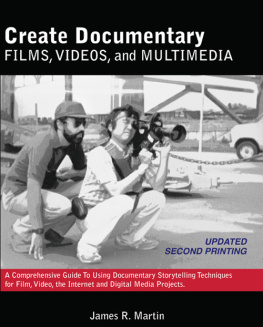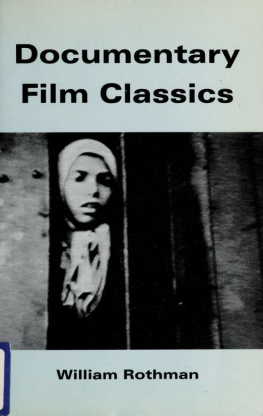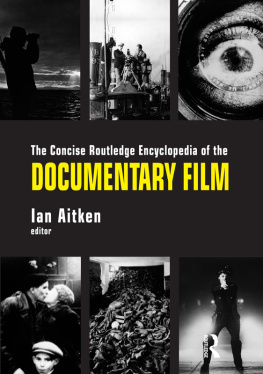These documentaries have been widely seen and discussed, and have been in many cases at the center of controversies; in other cases they have provided valuable teaching resources. They are all accessible for renting or buying for your private collection. You can use the index to this book and other books mentioned in the references, imdb.com, your local library, Netflix, Google, and the Library of Congress to find out more about why these films have attracted attention and esteem. Viewing this collection will set you up nicely with a context to watch your latest favorite, argue with this list, and build your own top one hundred.
Nanook of the North, 1922
Grass, 1925
Berlin, Symphony of a Great City, 1927
The Fall of the Romanov Dynasty, 1927
Man with a Movie Camera, 1929
Rain, 1929
Land without Bread (Las Hurdes), 1932
Man of Aran, 1934
Song of Ceylon, 1934
Triumph of the Will, 1934
Night Mail, 1936
The Plow that Broke the Plains, 1936
Spanish Earth, 1937
Power and the Land, 193940
Listen to Britain, 1942
Why We Fight, 1942
Battle of San Pietro, 1945
Farrebique, 1946
Matres Fou, Les (Crazy Masters), 1955
Night and Fog, 1955
Tire Die, 1958
Primary, 1960
Chronicle of a Summer, 1961
Mothlight, 1963
Battle of Culloden, 1964
Tokyo Olympiad, 1965
Dont Look Back, 1967
Titicut Follies, 1967
Warrendale, 1967
Hour of the Furnaces, 1968
Salesman, 1968
High School, 1969
Sorrow and the Pity, 1969
Selling of the Pentagon, 1971
World at War, 1973
Hearts and Minds, 1974
Ax Fight, 1975
Battle of Chile, 197579
The Wedding Camels, 1976
Harlan County USA, 1976
How the Myth Was Made, 1978
The Last Waltz, 1978
With Babies and Banners, 1978
Trobriand Cricket, 1979
The Life and Times of Rosie the Riveter, 1980
N!ai: The Story of a !Kung Woman, 1980
Garden of Earthly Delights, 1981
Atomic Caf, 1982
Burden of Dreams, 1982
Sans Soleil (Sunless), 1982
First Contact, 1983
When the Mountains Tremble, 1983
Cabra Marcado para Morrer (Twenty Years Later, a.k.a. A Man Listed to Die), 1984
Shoah, 1985
From the Pole to the Equator, 1986
Handsworth Songs, 1986
Shermans March, 1986
Eyes on the Prize, 198790
Cane Toads, 1988
The Emperors Naked Army Marches On, 1988
The Thin Blue Line, 1988
Roger & Me, 1989
Tongues Untied, 1989
Body Beautiful, 1990
The Civil War, 1990
Paris Is Burning, 1990
Allah, Tantou, 1991
Afrique, Je Te Plumerai, 1992
Lumumba, Death of a Prophet, 1992
The War Room, 1993
The Wonderful, Horrible Life of Leni Riefenstahl, 1993
Hoop Dreams, 1994
Celluloid Closet, 1995
Taking Pictures, 1996
4 Little Girls, 1997
Chile, Obstinate Memory, 1997
42 Up, 1998
What Farocki Taught, 1998
Cinma vrit, 1999
Gleaners and I, 2000
Stranger with a Camera, 2000
Dogtown and Z-Boys, 2001
Fighter, 2001
Winged Migration, 2001
Amandla!, 2002
Bus 174, 2002
The Day I Will Never Forget, 2002
Rivers and Tides, 2002
Checkpoint, 2003
Fog of War, 2003
Control Room, 2004
Fahrenheit 9/11, 2004
From the Ikpeng Children to the World, 2004
The New Americans, 2004
Super Size Me, 2004
Tintin and I, 2004
Video Letters, 2004
A Decent Factory, 2005
Three Rooms of Melancholia, 2005
An Inconvenient Truth, 2006
I have included here the most important texts I consulted in writing the book (in the case of prolific authors not all their books are referenced). Grant and Sloniowski, Warren and Izod, et al. are all essay collections featuring authors I have referred to in the text. The place where I and almost everybody else started was, of course, Erik Barnouw.
Films
McLaren, Les, and Annie Stiven. Taking Pictures. First Run Icarus, 1996.
Mller, Ray. The Wonderful Horrible Life of Leni Riefenstahl. Kino on Video, 1998.
Stoney, George. How the Myth Was Made. Available on the Home Vision DVD of Man of Aran, 1978.
Wintonick, Peter. Cinema vrit: Defining the Moment. National Film Board of Canada, 1999.
Print
Aitken, Ian. Film and Reform: John Grierson and the Documentary Film Movement. London: Routledge, 1990.
_____. The Documentary Film Movement: An Anthology. Edinburgh: Edinburgh University Press, 1998.
Alexander, William. Film on the Left: American Documentary Film from 1931 to 1942. Princeton, NJ: Princeton University Press, 1981.
Anderson, Joseph L., and Donald Richie. The Japanese Film: Art and Industry. Princeton, NJ: Princeton University Press, 1982.
Aufderheide, Patricia. The Daily Planet: A Critic on the Capitalist Culture Beat. Minneapolis: University of Minnesota Press, 2000.
Aufderheide, Patricia, and Peter Jaszi, Untold Stories: Creative Consequences of the Rights Clearance Culture for Documentary Filmmakers. Washington, DC: Center for Social Media, American University, 2004.
Barnouw, Erik. Tube of Plenty: The Evolution of American Television. New York: Oxford University Press, 1982.
_____. Documentary: A History of the Non-fiction Film. New York: Oxford University Press, 1993.
_____. Media Marathon: A Twentieth-Century Memoir. Durham, NC: Duke University Press, 1996.
Barsam, Richard. Nonfiction Film: A Critical History. New York: Dutton, 1973.
Beattie, Keith. Documentary Screens: Non-fiction Film and Television. New York: Palgrave Macmillan, 2004.
Benson, Thomas W., and Carolyn Anderson. Reality Fictions: The Films of Frederick Wiseman. Carbondale, IL: Southern Illinois University Press, 1989.
Bernard, Sheila Curran. Documentary Storytelling for Film and Videomakers. Boston: Focal Press, 2004.
Bluem, A. William. Documentary in American Television: Form, Function [and] Method. Hastings House, 1965.
Bous, Derek. Wildlife Films. Philadelphia: University of Pennsylvania Press, 2000.
Boyle, Deirdre. Subject to Change: Guerrilla Television Revisited. New York: Oxford University Press, 1997.
Burton, Julianne. The Social Documentary in Latin America. Pittsburgh, PA: University of Pittsburgh Press, 1990.
Campbell, Richard. 60 Minutes and the News: A Mythology for Middle America. Urbana: University of Illinois Press, 1991.
Campbell, Russell. Cinema Strikes Back: Radical Filmmaking in the United States, 19301942. Ann Arbor, MI: UMI Research Press, 1982.
Carey, James W.







